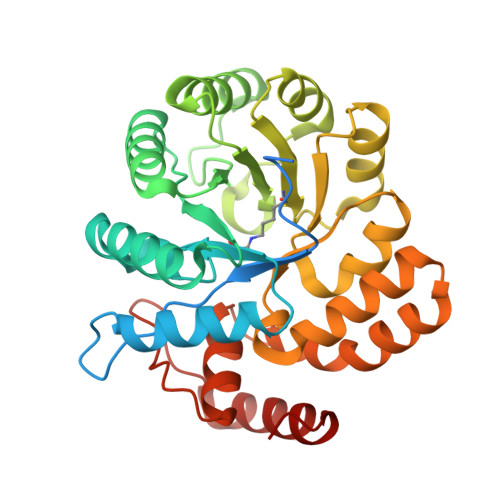Structure and Function of Cyanobacterial DHDPS and DHDPR.
Christensen, J.B., Soares da Costa, T.P., Faou, P., Pearce, F.G., Panjikar, S., Perugini, M.A.(2016) Sci Rep 6: 37111-37111
- PubMed: 27845445
- DOI: https://doi.org/10.1038/srep37111
- Primary Citation of Related Structures:
5KTL - PubMed Abstract:
Lysine biosynthesis in bacteria and plants commences with a condensation reaction catalysed by dihydrodipicolinate synthase (DHDPS) followed by a reduction reaction catalysed by dihydrodipicolinate reductase (DHDPR). Interestingly, both DHDPS and DHDPR exist as different oligomeric forms in bacteria and plants. DHDPS is primarily a homotetramer in all species, but the architecture of the tetramer differs across kingdoms. DHDPR also exists as a tetramer in bacteria, but has recently been reported to be dimeric in plants. This study aimed to characterise for the first time the structure and function of DHDPS and DHDPR from cyanobacteria, which is an evolutionary important phylum that evolved at the divergence point between bacteria and plants. We cloned, expressed and purified DHDPS and DHDPR from the cyanobacterium Anabaena variabilis. The recombinant enzymes were shown to be folded by circular dichroism spectroscopy, enzymatically active employing the quantitative DHDPS-DHDPR coupled assay, and form tetramers in solution using analytical ultracentrifugation. Crystal structures of DHDPS and DHDPR from A. variabilis were determined at 1.92 Å and 2.83 Å, respectively, and show that both enzymes adopt the canonical bacterial tetrameric architecture. These studies indicate that the quaternary structure of bacterial and plant DHDPS and DHDPR diverged after cyanobacteria evolved.
Organizational Affiliation:
Department of Biochemistry and Genetics, La Trobe Institute for Molecular Science, La Trobe University, Bundoora, Victoria 3086, Australia.
















